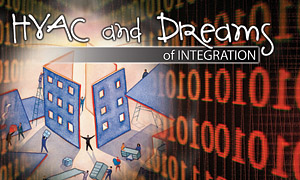
AutomatedBuildings.com
|
[an error occurred while processing this directive] |
New Contributing Editor Anto Budiardjo |
Welcome and Introduction by Ken Sinclair |
Please join me in welcoming Anto to AutomatedBuildings.com's
group of excellent contributing editors.
Anto Budiardjo is the President and CEO of Clasma, Inc., a marketing and event planning company whose primary focus is providing professional services to the full spectrum of the building systems industry.
Anto is no stranger to our online magazine as the creator of BuilConn has been a constant industry news generator. We are just getting around to making it official.
We have given him his own page and listed and linked all his articles and interviews.
Anto has joined us in the preparation of our third pull out supplement on convergence "Marketing" Convergence" prepared for the November issue of Engineered Systems. Jack McGowan, Anto and I outline the importance of our industry getting involved now in the marketing of convergence.
XML Marketing. In conversations with Paul Ehrlich and task group leaders, it has been decided that Anto will lead a marketing, communications & PR task group to help manage the XML initiative. I am extremely pleased to connect Anto directly to his public to allow him complete editorial freedom to take this important message to the readership.
Did you see his August cover story Engineered Systems?
 Cover
Story
Cover
Story
HVAC
and Dreams of Integration
While the HVAC industry is
poised to do well in integration, it isn't a given. Take a minute and get the
big picture by starting with the building controls dream, then moving into the
present and toward the future.
By Anto Budiardjo
It is an excellent article we must all read, but I want to pull out of the article Anto's definition of XML
Enter
XML
In a similar way that HTML describes
information for human visual consumption, XML (eXtensible markup language) is a
new protocol whose job is to describe information not necessarily destined for
human visual consumption. XML describes the meaning of data in a manner that two
devices on a TCP/IP network can understand. Thus, it is XML that holds the key
to the use of the Internet and other TCP/IP networks for building controls. As
an aside, XML is also the de facto technology being used by many other
industries to carry its data across TCP/IP networks such as the Internet.
|
[an error occurred while processing this directive] |
Because XML is so ideally suited for intersystem and interdevice communication, it should be the ideal technology for communication between HVAC controllers as well as integrating building systems, right? Not so fast! There is one small problem still to be solved. XML is a method and technology to describe data, but for it to be useful carrying HVAC and other building relevant data, all the players in the building systems industry must first agree on the description and meaning of the data that is being carried using XML. Without such agreement, XML will be used in many different 'proprietary' manners with little or no possibility for multivendor systems to work together.
Efforts in this area are currently underway, and a group of industry leaders embarked on this effort in April 2003, as part of the BuilConn Forum in Dallas. Supported by the Continental Automated Buildings Assoiation (CABA) along with the participation of engineers from the LonWorks and BACnet communities, this group is driven by a need to define the use of XML in buildings.
Will this group succeed? The answer has to be yes. The prospect of not being able to use TCP/IP networks to exchange HVAC and building system information cannot be acceptable for our industry. The benefits are simply too significant for this initiative to fail.
So, what of LonWorks and BACnet? They will continue to have a very important role in buildings; TCP/IP networks simply cannot scale connectivity down to the smallest device level such as sensors, actuators, light fittings, intrusion, or fire and smoke detection devices. LonWorks and BACnet also have something that the XML initiatives need: the information definitions that both groups have worked on for many years including LonWorks' LonMark profiles and SNVT (standard network variable types) definitions and BACnet's BIBBs (BACnet interoperability building blocks) and objects.
So given some time, TCP/IP networks such as
the Internet will carry XML data with useful building systems information based
on some combination of LonMark and BACnet object definitions. Is this the end of
the story? Not quite yet; there is one very significant challenge still to
overcome, a challenge that if not addressed by the industry will negate all of
the benefits of the technology we have available.
I look forward to helping Anto with the
XML/Web
Services for Buildings Marketing, Communications & PR Group, please provide
him your support. Welcome Anto.
[an error occurred while processing this directive]
[Click Banner To Learn More]
[Home Page] [The Automator] [About] [Subscribe ] [Contact Us]